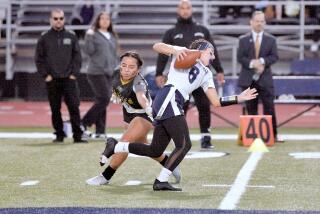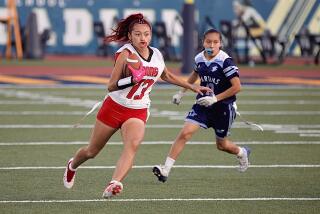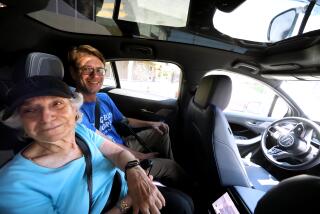This In-Line Skater Was Out of Line
- Share via
Dear Street Smart:
I recently observed a young woman on roller-blades, skating along Sunny Crest Drive in Fullerton where there is no sidewalk. Farther up the hill, however, where there is a sidewalk, I encountered her skating along the street about 12 feet from the curb, having made little effort to get closer to the curb after passing a parked car. What really threw me, and several other drivers as well, was that when she made a left turn, she did it from the right side of the left-turn pocket as if she were a bicyclist!
The driver of the car to her right didn’t know what to do, and people behind honked, not knowing what the delay was. Coming from a dead stop, of course, she had some difficulty getting her momentum up again, which was compounded by a dip at the side of the road through which she had to maneuver. Once through the intersection, she got on the sidewalk and looked over her shoulder as if she’d been slighted.
Shouldn’t she have used the crosswalks to get across the streets? And where, exactly, should someone on roller-blades be riding?
Judy Berg
Fullerton
People on roller-blades are considered pedestrians and should use crosswalks and stay on the sidewalk when one is available, according to Anne Richards, a spokeswoman for the California Highway Patrol. Where there is no sidewalk, Richards said, roller-bladers must stay as close as possible to the side of the road.
*
Dear Street Smart:
For two years, I drove the Century Freeway(I-105) to work. One day, I was driving west about 11 a.m. What should have been an easy drive took the longest it ever took because only one lane was open due to Caltrans roadwork on the right lanes.
My question is, if two or even three lanes are closed, leaving only one traffic lane and the carpool lane open, and it’s not by any stretch of the imagination rush hour, is it permissible for a solo driver to use the carpool lane? I was sorely tempted but was not willing to risk the $271 fine.
Debby Patterson
La Habra
You did the right thing by staying out of the carpool lane. The inconvenience of road work does not change state law, Richards said, which holds that carpool lanes are to be used by cars with multiple occupants only, regardless of what Caltrans may be doing.
*
Dear Street Smart:
I’ve been told that when approaching a traffic signal at night, flashing your high beams will make the light change faster. Is this true, or do the lights change strictly on the ground sensors?
Mike Higgins
Fountain Valley
Traffic signals are not affected by your high beams. The idea that they would be, however, may have its roots in the fact that some Orange County cities use a technology that allows emergency vehicles to trigger traffic signals. Their lights are calibrated to a special frequency designed to trip an above-ground detector that turns the traffic light green and allows the ambulance, fire engine or police car to pass.
In Fountain Valley, however, the traffic signals are keyed to timers or traffic sensors in the ground.
*
Speaking of triggering traffic signals, a reader has what he describes as a “simple solution” for motorcyclists who can’t seem to get their vehicles to trip those underground sensors. In last week’s column, Orange County traffic engineer Ignacio Ochoa suggested motorcyclists stay in the middle of their lanes and avoid crossing the limit line at the beginning of the intersection.
Not quite on the mark, writes Rhett S. Price, a CHP officer who rides a motorcycle all day. The underground sensors create a circular or square magnetic field designed to detect a mass of metal that passes over it. Because the field is strongest at its outer edges, Price writes, the best tactic for a motorcyclist is to ride near the edge of the lane. If necessary, he says, you can even “lean the motorcycle over to increase its mass.” In other words, the more pavement the cycle covers, the more likely it is to be detected.
The tactic, Price says, “has worked 99.9% of the time for me, and I recommend it to other motorcyclists.”
*
Finally, an interesting sidebar to the March 9 column on Dennis Strawn, a Laguna Niguel banker who patented his idea for a U-turn signal and is trying to make it required equipment on new cars. Apparently, Strawn, 50, is not the first Orange County resident to recognize the problem of unanticipated U-turns; in 1990, two Mission Viejo women, Maureen Sullivan and Elizabeth Himelson, obtained a patent on a slightly different device designed to do the same thing.
In an effort to sell the idea, the pair wrote, they sent 1,200 letters to vehicle manufacturers nationwide, highway patrol chiefs in all 50 states and legislators they thought would be interested. The outcome: “While many who drive emergency vehicles were quite interested,” the women reported, “vehicle manufacturers were not. Our letters were returned with a note from counsel saying ‘our company’ does not consider ideas from the outside public.”
Strawn and his partner, JoHanna Levison, say they are not discouraged by such news. “We’re making some progress,” Strawn said. “We’re going to continue to try and contact every major auto manufacturer.”
*
Street Smart appears Mondays in The Times Orange County Edition. Readers are invited to submit comments and questions about traffic, commuting and what makes it difficult to get around in Orange County. Include simple sketches if helpful. Letters may be published in upcoming columns. Please write to David Haldane, c/o Street Smart, The Times Orange County Edition, P.O. Box 2008, Costa Mesa, CA 92626, send faxes to (714) 966-7711 or e-mail him at [email protected] Include your full name, address and day and evening phone numbers. Letters may be edited, and no anonymous letters will be accepted.


